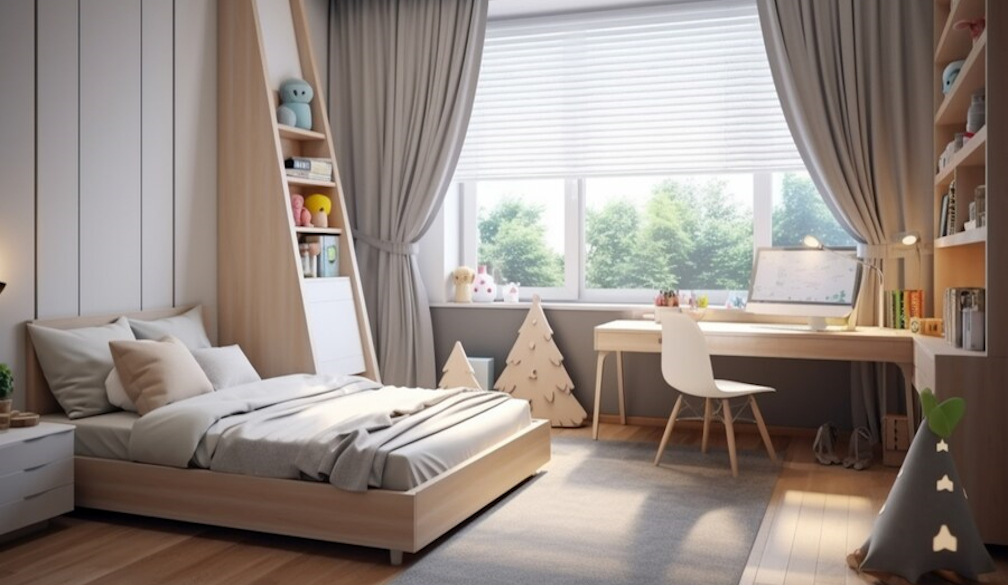Styling Tips for Incorporating Rugs and Blinds in Your Interior Design

Importance of Rugs and Blinds in Interior Design
Rugs and blinds are two essential elements that can significantly impact the overall aesthetic and functionality of your interior design. These seemingly simple additions can transform a space, elevating the overall look and feel of your home. Rugs, for instance, can anchor a room, define distinct areas, and add warmth and texture to the environment. Blinds, on the other hand, offer practical benefits such as light control and privacy, while also contributing to the visual appeal of a space.
Beyond their practical applications, rugs and blinds can also be used as powerful design tools to express your personal style and create a cohesive, visually harmonious interior. By carefully selecting and styling these elements, you can enhance the overall ambiance of a room, create a sense of balance and proportion, and tie together the various design elements in your space. Whether you're looking to create a cozy and inviting living room, a serene and relaxing bedroom, or a stylish and functional office, the strategic use of rugs and blinds can make all the difference.
In this comprehensive guide, we will delve into the world of rugs and blinds, exploring the different types, sizes, and shapes available, as well as the best practices for incorporating them into your interior design. We'll share expert styling tips, offer advice on coordinating colors and patterns, and provide insights on how to maintain and care for these essential design elements. By the end of this article, you'll be equipped with the knowledge and inspiration to transform your space with the perfect combination of rugs and blinds.
Types of Rugs for Different Rooms
When it comes to selecting the right rug for your interior design, it's important to consider the specific needs and characteristics of the room you're working with. Different rooms have different functional and aesthetic requirements, and the choice of rug can significantly impact the overall feel and atmosphere of the space.
For living rooms, a large area rug can be an excellent choice, as it helps to anchor the furniture and define the seating area. Look for rugs with patterns, textures, or colors that complement your existing decor, and consider the size of the rug in relation to the size of the room. A rug that is too small can make the space feel disconnected, while a rug that is too large can overwhelm the room.
In the bedroom, a plush, cozy rug can add a sense of warmth and comfort. Consider a rug that extends beyond the bed frame, creating a soft and inviting surface for your feet when you step out of bed. Alternatively, you can use a smaller rug on either side of the bed to create a more defined sleeping area.
For dining rooms, a rug can help to define the dining area and provide a visual anchor for the table and chairs. Look for a rug that is slightly larger than the dining table, allowing for enough space for chairs to be pulled out without catching on the edges of the rug.
In home offices or study spaces, a rug can help to create a sense of separation and focus, while also adding a touch of personality to the room. Consider a patterned or textured rug that complements the overall aesthetic of the space, and choose a size that allows for comfortable movement around the desk and other furniture.
Ultimately, the choice of rug should be guided by the specific needs and characteristics of the room, as well as your personal style and design preferences. By carefully selecting the right rug for each space, you can enhance the overall functionality and visual appeal of your interior design.
Choosing the Right Size and Shape of Rugs
When it comes to incorporating rugs into your interior design, the size and shape of the rug can have a significant impact on the overall look and feel of the space. Choosing the right size and shape can help to create a harmonious and balanced aesthetic, while the wrong choice can disrupt the flow and proportion of the room.
One of the most important considerations when selecting a rug is its size. A rug that is too small for the space can make the room feel disconnected and unfinished, while a rug that is too large can overwhelm the space and make the room feel cramped. As a general rule, the rug should be large enough to anchor the furniture and create a cohesive, defined area.
For living rooms, a good rule of thumb is to choose a rug that is large enough to have at least the front legs of all the furniture pieces resting on it. This helps to create a sense of unity and balance in the space. Alternatively, you can opt for a rug that is just slightly smaller than the seating area, allowing for a few inches of floor space around the edges.
In the bedroom, the size of the rug should be determined by the size of the bed and the overall layout of the room. A rug that extends beyond the bed frame, creating a soft and inviting surface for your feet, can be a great choice. Alternatively, you can use smaller rugs on either side of the bed to define the sleeping area.
When it comes to the shape of the rug, there are a variety of options to choose from, including rectangular, square, round, and even custom-shaped rugs. The shape of the rug should be chosen based on the overall layout and proportions of the room, as well as your personal style preferences.
Rectangular rugs are a versatile option that can work well in a variety of spaces, from living rooms to dining rooms. Square rugs can be a great choice for smaller spaces, as they can help to create a sense of balance and symmetry. Round rugs, on the other hand, can add a touch of softness and organic feel to a space, and can be particularly well-suited for rooms with curved or irregular shapes.
Ultimately, the choice of rug size and shape should be guided by the specific needs and characteristics of the room, as well as your personal design preferences. By carefully selecting the right rug, you can enhance the overall look and feel of your interior design and create a harmonious and visually appealing space.
Selecting the Perfect Blinds for Your Windows
Blinds are an essential element of any interior design, offering both practical and aesthetic benefits. Not only do they provide privacy and light control, but they can also significantly contribute to the overall visual appeal of a space. When it comes to selecting the perfect blinds for your windows, there are a variety of factors to consider, from the material and color to the style and functionality.
Are you ready to transform your space with beautiful blinds? Well, one of the first decisions you'll need to make is choosing the material for your blinds, and let me tell you, the options are endless! From the natural beauty of wood to the durability of vinyl, there's a material for every style and need. So, how do you decide? By exploring the characteristics and benefits of each material, of course! Whether you're looking for a timeless and elegant look or a budget-friendly option, clicking here will give you all the information you need to make the perfect choice. Don't wait any longer, let's find the perfect blinds for your room and bring your design goals to life!
Wooden blinds, for example, can add a warm and natural touch to a space, and are particularly well-suited for traditional or rustic-inspired interiors. Faux wood blinds, on the other hand, offer a similar aesthetic at a more affordable price point, and are often more durable and easy to maintain. Vinyl blinds are a popular choice for their durability and easy cleaning, while fabric blinds can add a soft and inviting touch to a space, particularly in bedrooms and living rooms.
In addition to the material, the color of your blinds is also an important consideration. Opt for a color that complements your existing decor and creates a cohesive look throughout the space. Neutral tones like white, beige, or gray can be a versatile choice that works well in a variety of interior styles, while bolder colors can add a pop of personality and visual interest.
When it comes to the style of your blinds, there are a variety of options to choose from, including vertical blinds, horizontal blinds, and cellular shades. Vertical blinds can be a great choice for larger windows or sliding glass doors, as they offer a sleek and modern look. Horizontal blinds, on the other hand, can be a classic and versatile option that works well in a variety of spaces. Cellular shades, which feature a honeycomb-like structure, can provide excellent insulation and light control, making them a popular choice for energy-efficient homes.
Ultimately, the choice of blinds should be guided by the specific needs and characteristics of the room, as well as your personal design preferences. By carefully selecting the right blinds, you can enhance the overall look and feel of your interior design and create a space that is both functional and visually appealing.
Coordinating Colors and Patterns with Rugs and Blinds
When it comes to incorporating rugs and blinds into your interior design, the key to creating a cohesive and visually harmonious space lies in the careful coordination of colors and patterns. By thoughtfully selecting and pairing these elements, you can elevate the overall aesthetic of your space and create a seamless, visually appealing environment.
One of the most important considerations when coordinating colors and patterns is to ensure that they complement each other and work within the overall color palette of the room. This doesn't necessarily mean that the colors and patterns need to be an exact match, but rather that they should create a sense of balance and unity.
For example, if you have a neutral-toned rug with a subtle pattern, you might consider pairing it with blinds in a complementary neutral shade, such as beige or gray. Alternatively, if you have a boldly patterned rug, you could opt for a solid-colored blind in a color that is present within the rug's design, creating a harmonious and visually interesting look.
When it comes to mixing patterns, it's important to strike a balance and avoid creating a cluttered or overwhelming look. One approach is to choose a rug with a larger-scale pattern and pair it with blinds that have a smaller, more subtle pattern or texture. This can create a visually interesting and layered effect without feeling too busy.
Another strategy is to choose a rug and blinds that share a common color palette, even if the patterns are different. This can help to create a cohesive and harmonious look, while still allowing for a touch of visual interest and personality.
It's also worth considering the overall style and aesthetic of your interior design when coordinating colors and patterns. For a more traditional or rustic-inspired space, you might opt for natural fibers, earthy tones, and subtle patterns. In a modern or minimalist setting, you might choose sleek, monochromatic blinds and a geometric-patterned rug to create a clean and streamlined look.
Ultimately, the key to successful color and pattern coordination lies in experimentation, an eye for balance, and a deep understanding of your personal design preferences. By carefully selecting and pairing your rugs and blinds, you can create a cohesive and visually appealing interior that reflects your unique style and enhances the overall functionality of your space.
Layering Rugs for Added Style and Comfort
One of the most effective ways to elevate the visual interest and comfort of a space is through the strategic layering of rugs. By combining different textures, patterns, and sizes of rugs, you can create a visually dynamic and inviting environment that reflects your personal style and enhances the overall functionality of the room.
Layering rugs can be particularly effective in living rooms, where it can help to define distinct seating areas and create a sense of cozy, intimate atmosphere. Start with a larger, more substantial area rug that serves as the foundation for the space, and then layer smaller, more decorative rugs on top to add visual interest and texture.
For example, you might begin with a neutral-toned, natural fiber area rug that covers the majority of the living room floor. Then, you could layer a smaller, patterned rug in front of the sofa or in the conversation area, creating a visual focal point and adding a touch of personality to the space.
In the bedroom, layering rugs can also be a great way to enhance the overall comfort and coziness of the space. Start with a larger rug that extends beyond the bed frame, creating a soft and inviting surface for your feet. Then, layer smaller rugs on either side of the bed or at the foot of the bed to add additional texture and visual interest.
When it comes to selecting the rugs for layering, it's important to consider the overall color palette and design aesthetic of the room. Opt for rugs that complement each other in terms of color, pattern, and texture, while still creating a visually interesting and dynamic look.
For example, you might choose a neutral-toned, low-pile area rug as the foundation, and then layer a plush, textured rug in a complementary color or pattern on top. Alternatively, you could choose rugs with contrasting patterns or textures to create a more eclectic and visually striking look.
Regardless of the specific rugs you choose, the key to successful rug layering is to experiment and find the right balance between visual interest and cohesion. By layering your rugs with care and attention to detail, you can create a warm, inviting, and visually appealing space that reflects your personal style and enhances the overall functionality of your interior design.
Maintenance and Care Tips for Rugs and Blinds
Maintaining the beauty and longevity of your rugs and blinds is essential for preserving the overall aesthetic and functionality of your interior design. Proper care and maintenance can not only extend the lifespan of these essential design elements but also ensure that they continue to enhance the look and feel of your space for years to come.
When it comes to caring for your rugs, regular vacuuming is a must. Aim to vacuum your rugs at least once a week, using the appropriate attachment for the type of rug you have. This will help to remove dirt, debris, and pet hair, preventing it from becoming embedded in the fibers and causing damage over time.
In addition to vacuuming, it's important to periodically deep clean your rugs to remove any stubborn stains or built-up grime. Depending on the type of rug, you may be able to use a mild soap and water solution or a specialized rug cleaning product. Be sure to follow the manufacturer's instructions carefully and test any cleaning solution in an inconspicuous area first to ensure it doesn't cause any discoloration or damage.
For blinds, regular dusting and cleaning is essential to maintain their appearance and functionality. Use a soft, microfiber cloth to gently wipe down the slats or vanes, removing any accumulated dust or dirt. For more thorough cleaning, you can use a mild soap and water solution or a specialized blind cleaning product, making sure to thoroughly dry the blinds after cleaning to prevent any water spots or warping.
It's also important to consider the specific care and maintenance requirements of the materials used in your blinds. For example, wooden or faux wood blinds may require occasional oiling or conditioning to prevent cracking or fading, while fabric blinds may need to be professionally cleaned to remove any stubborn stains or odors.
By taking the time to properly maintain and care for your rugs and blinds, you can ensure that they continue to look their best and enhance the overall aesthetic of your interior design. Regular cleaning and attention to detail can go a long way in preserving the beauty and functionality of these essential design elements for years to come.
Styling Tips for Different Interior Design Styles
When it comes to incorporating rugs and blinds into your interior design, the key to success lies in aligning these elements with the overall style and aesthetic of your space. Whether you're going for a modern, minimalist look or a cozy, traditional vibe, the right combination of rugs and blinds can help to elevate the overall design and create a cohesive, visually appealing environment.
In a modern, minimalist space, you'll want to opt for clean lines, neutral colors, and simple patterns. Consider sleek, low-profile blinds in shades of white, gray, or black, which can create a streamlined and sophisticated look. For your rugs, choose natural fibers like jute or sisal, or opt for a geometric-patterned rug in a muted color palette to complement the overall aesthetic.
For a more traditional or rustic-inspired interior, you can incorporate warmer tones, natural textures, and more intricate patterns. Wooden blinds in a rich, honey-toned finish can add a touch of warmth and character to the space, while a vintage-inspired, patterned rug can anchor the room and create a cozy, inviting atmosphere.
In a bohemian or eclectic space, you can have a bit more fun with your rug and blind choices, mixing and matching different textures, colors, and patterns to create a visually dynamic and personality-filled environment. Consider layering rugs with contrasting patterns and colors, and pair them with bamboo or woven blinds for a natural, earthy feel.
For a coastal or nautical-inspired interior, you might opt for lighter, airier colors and natural materials. White or light-colored blinds can create a sense of openness and brightness, while a striped or sea-inspired rug can add a touch of beachy charm to the space.
Ultimately, the key to successful styling with rugs and blinds is to consider the overall design aesthetic of your space and choose elements that complement and enhance the existing decor. By aligning your rug and blind choices with the broader style of your interior, you can create a cohesive and visually appealing environment that reflects your personal taste and design sensibilities.





